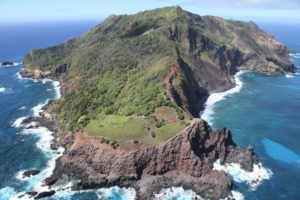Maybe one of the fantasies those everybody has at the end of each phase of the life, is to live in a island. One of my dreams for example, is to visit one of my favourite islands in the world: Pitcairn Islands (United Kingdom overseas territory), in the South Pacific Ocean. When I knew the story of the 23 mutineers of the HMS Bounty in the 18th century, who chose that island to live and die, I always ask myself which is the misterious charm that this island encloses.

The story of the Bounty mutiny is extraordinary, for several reasons. It was in a British ship, in times when Britain was leading the war of seas. It was exactly in 1789, the same year when the French Revolution began, with those marvelous ideals of freedom and equality, but England refused to keep in the same way. The tragic incident in the Bounty reflected this conflict in a minimum scale. It was also a clash of leaderships, because Lieutenant William Bligh (who served also as Master and Commander and Captain) represented the order, the discipline and loyalty to the rules and Fletcher Christian, formerly´s Bligh friend, but also one of his officers in the ship, refused his authority and became the leader of the mutineers. Moreover, the mutiny opened the possibility of the mutineers to create an absolute new and an egualitarian society in Rousseaunian terms, in Pitcairn Islands, so far of the control of the Royal Navy, which wanted thir heads on hanging because of their breaking rules of the British Marine. Finally, maybe, the story symbolized once again, an intercultural love affair between the white men (the British) and the natives, especially Tahitian women. But they paid a high price for the paradise promised and expected: when 18 years later, an American whale ship rediscovered the island, it found one man (John Adams), with nine women and 23 children. It is assumed that Christian died on Pitcairn Island in September 1793.
The mutiny on the Bounty was described in five films, in 1916, 1933, 1935, 1962 y 1984. Fletcher Christian was portrayed by Wilton Power, Errol Flynn, Clark Gable, Marlon Brando and Mel Gibson, respectively. “The Bounty”, directed by Roger Donaldson and produced by Dino de Laurentiis, released in 1984, is less sympathetic to Christian than previous treatments were. Welsh actor Anthony Hopkins was in a superb level, playing the role of Captain Bligh. The film also features Laurence Olivier, Edward Fox, Daniel Day-Lewis and Liam Neeson. The music score was composed by Vangelis.

Precisely, Bligh, who traveled before with the famous Captain James Cook, faced with his Bounty´s crew’s increasing laxity after an idyllic visit to Tahiti: the search for breadfruit takes second place to limitless sex with the island girls. Bligh was forced to resort to flogging and other such means to keep his men in line. Mr. Christian, Masters´s Mate of the ship, was of little use to the captain, having fallen in love with a native girl (named Mauatua) himself. So, Christian seized command of the ship from Bligh on 28 April 1789. It has also been argued that they were motivated by Bligh’s allegedly harsh treatment of them. Mutineers set Bligh afloat in a small boat with eighteen of the twenty-two crew loyal to him, including the Sailing Master John Fryer, Midshipman Thomas Hayward, Boatswain William Cole, Quarter Master John Norton (killed by natives in Tofua, 2 May 1789) and others.
Following the mutiny, Christian attempted to build a colony on Tubuai, but there the mutineers came into conflict with natives. Abandoning the island, he stopped briefly in Tahiti where he married Mauatua, the daughter of one of the local chiefs, on 16 June 1789. While on Tahiti, he dropped off sixteen crewmen. These sixteen included four Bligh loyalists who had been left behind on Bounty and two who had neither participated in, nor resisted, the mutiny. The remaining nine mutineers, six Tahitian men and eleven Tahitian women then sailed eastward. In time, they landed on Pitcairn Islands, where they stripped Bounty of all that could be floated ashore before the Able Seaman Matthew Quintal set it on fire, stranding them.
The resulting sexual imbalance, combined with the effective enslavement of the Tahitian men by the mutineers, led to insurrection and the deaths of most of the men. After three years, a conflict broke out between the Tahitian men and the mutineers, resulting in the deaths of all the Tahitian men and five of the Englishmen (including Fletcher Christian). Adams and Mauatua claimed Christian had been murdered during the conflict between the Tahitian men and the mutineers. According to an account by a Pitcairn woman named Jenny who left the island in 1817, Christian was shot while working by a pond next to the home of his pregnant wife. But also rumours have persisted for more than two hundred years that Christian’s murder was faked, that he had left the island and that he made his way back to England.
Matthew Quintal was one of the survivors. One of the other survivors, the Able Seaman William McCoy, discovered a means of distilling alcohol from one of the island’s fruits. He and Quintal quickly descended into alcoholism, often bullying the surviving women. McCoy committed suicide by jumping off a cliff in a drunken frenzy. After McCoy’s suicide, Quintal threatened to kill the rest of the community. The other two surviving men, Ned Young and John Adams, subsequently killed him with an axe during one of his drunken stupors.
The mutineers remained undetected on Pitcairn until February 1808, when sole remaining mutineer John Adams and the surviving Tahitian women and their children were discovered by the Boston sealer Topaz, commanded by Captain Mayhew Folger of Nantucket, Massachusetts. He also proved there that the dream of the French Revolution but in a British ship, was over.
John Adams looked after the remaining community of women and children. He taught the children and converted the community to Christianity. He was eventually pardoned of his crime by the British Admiralty for the work that he had done for the island and allowed to live on the island for the rest of his life. Now, Pitcairn Islands is occupied by 50 inhabitants, descendants of those mutineers and natives.
The details of this extraordinary voyage of HMS Bounty are very well documented, largely due to the effort of Bligh to maintain an accurate log before, during, and after the actual mutiny. Bounty‘s crew list is also well chronicled, down to and including the names of every seaman on board, something which larger ships in the rating system only occasionally were capable of due to crews in the hundreds whereas the Bounty carried fewer than fifty personnel.
Bligh’s original log remained intact throughout his ordeal and was used as a major piece of evidence in his own trial for the loss of the Bounty as well as the subsequent trial of captured mutineers. The original log is presently maintained at a museum in New South Wales with available transcripts in both print and electronic format.
1787, 16 August: William Bligh is ordered to command a breadfruit gathering expedition to Tahiti.
3 September: Bligh sets out from Great Britain in December 1787, electing to sail the Bounty west round the tip of South America in an attempt to use the expedition to fulfill an ambition to circumnavigate the globe.
1788, 26 February: Marked at 100 leagues from the eastern coast of Brazil.
23 March: Arrived Tierra del Fuego.
9 April: Entered the Strait of Magellan.
25 April: The attempt to round Cape Horn fails due to harsh weather, and the ship is obliged to take the longer eastern route.
22 May: Within sight of the Cape of Good Hope.
19 September: Past the southern tip of New Zealand.
26 October: Arrived Tahiti.
1789, 23–25 April: Anchored for provisions off Tonga.
28 April: Mutiny on the Bounty. Captain Bligh and loyal crew members set adrift in Bounty‘s launch.
From this point, Captain Bligh’s mission log reflects the voyage of the Bounty´s launch towards the Dutch East Indies. Bligh completed a voyage of more than 3,500 nautical miles (6,500 km) in the launch to reach safety, and began the process of bringing the mutineers to justice.
29 April: Bounty launch arrives at Tofua.
2 May: Bounty launch castaways flee Tofua after being attacked by natives. There, Norton was killed by natives.
3 June: Bounty launch sails into the open ocean towards Australia. In these deseperate hours, Bligh remmembered to their seamen that they were “civilized, not savages”.
14 June: Launch castaways circle Timor and land at Coupang, a Dutch colony. Mutiny was reported to Dutch authorities. This was the epic arrival of Captain Bligh and his loyal officers and seamen.
1790, 13 March. Bligh arrived to Portsmouth Harbour, England.






Encontraron el barco del Capitán Cook? https://www.ellitoral.com/index.php/id_um/179602-creen-haber-encontrado-los-restos-del-barco-de-james-cook-a-250-anos-de-la-muerte-del-explorador-internacionales.html
Horatio Hornblower, otro personaje ficticio de la navegación británica de fines del siglo XVIII e inicios del XIX. https://www.youtube.com/watch?v=0ezKHw8ocCM&list=PLLh1usqLUofLQjji9-Ts_SX-qnUjvAVZq
Why will nobody move to Pitcairn? https://www.telegraph.co.uk/news/worldnews/australiaandthepacific/pitcairnislands/11418280/Why-will-nobody-move-to-Pitcairn-the-Pacific-island-with-free-land.html